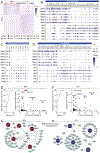Transcriptional and Spatial Resolution of Cell Types in the Mammalian Habenula
- PMID: 32272058
- PMCID: PMC7285796
- DOI: 10.1016/j.neuron.2020.03.011
Transcriptional and Spatial Resolution of Cell Types in the Mammalian Habenula
Abstract
The habenula complex is appreciated as a critical regulator of motivated and pathological behavioral states via its output to midbrain nuclei. Despite this, transcriptional definition of cell populations that comprise both the medial habenular (MHb) and lateral habenular (LHb) subregions in mammals remain undefined. To resolve this, we performed single-cell transcriptional profiling and highly multiplexed in situ hybridization experiments of the mouse habenula complex in naive mice and those exposed to an acute aversive stimulus. Transcriptionally distinct neuronal cell types identified within the MHb and LHb, were spatially defined, differentially engaged by aversive stimuli, and had distinct electrophysiological properties. Cell types identified in mice also displayed a high degree of transcriptional similarity to those previously described in zebrafish, highlighting the well-conserved nature of habenular cell types across the phylum. These data identify key molecular targets within habenular cell types and provide a critical resource for future studies.
Keywords: Act-seq; Habenula; HiPlex; SCENIC; Seurat; cross-species analysis; gene ontology analysis; mouse; scRNA-seq; zebrafish.
Copyright © 2020 Elsevier Inc. All rights reserved.
Conflict of interest statement
Declaration of Interests The authors declare no competing interests.
Figures







References
-
- Agetsuma M, Aizawa H, Aoki T, Nakayama R, Takahoko M, Goto M, Sassa T, Amo R, Shiraki T, Kawakami K, et al. (2010). The habenula is crucial for experience-dependent modification of fear responses in zebrafish. Nat. Neurosci 13, 1354–1356. - PubMed
-
- Aizawa H, Kobayashi M, Tanaka S, Fukai T, and Okamoto H (2012). Molecular characterization of the subnuclei in rat habenula. J. Comp. Neurol 520, 4051–4066. - PubMed
Publication types
MeSH terms
Grants and funding
LinkOut - more resources
Full Text Sources
Molecular Biology Databases

